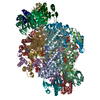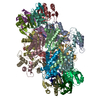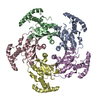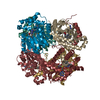+ Open data
Open data
- Basic information
Basic information
| Entry | Database: PDB / ID: 6z87 | ||||||
|---|---|---|---|---|---|---|---|
| Title | human GTP cyclohydrolase I | ||||||
 Components Components | GTP cyclohydrolase 1 GTP cyclohydrolase I GTP cyclohydrolase I | ||||||
 Keywords Keywords |  HYDROLASE / HYDROLASE /  GTP cyclohydrolase I / EC:3.5.4.16 / Tetrahydrobiopterin (BH4) synthesis / GTP cyclohydrolase I / EC:3.5.4.16 / Tetrahydrobiopterin (BH4) synthesis /  Cytosol / Zinc Ion Binding / Cytosol / Zinc Ion Binding /  Hydrolase Activity / Hydrolase Activity /  Metal Ion Binding / Metal Ion Binding /  Nucleotide Binding / allosteric inhibitor Nucleotide Binding / allosteric inhibitor | ||||||
| Function / homology |  Function and homology information Function and homology informationpteridine-containing compound biosynthetic process / regulation of lung blood pressure /  GTP cyclohydrolase I / GTP cyclohydrolase I /  GTP cyclohydrolase I activity / GTP cyclohydrolase I activity /  : / neuromuscular process controlling posture / regulation of removal of superoxide radicals / GTP-dependent protein binding / tetrahydrobiopterin biosynthetic process / neuron projection terminus ...pteridine-containing compound biosynthetic process / regulation of lung blood pressure / : / neuromuscular process controlling posture / regulation of removal of superoxide radicals / GTP-dependent protein binding / tetrahydrobiopterin biosynthetic process / neuron projection terminus ...pteridine-containing compound biosynthetic process / regulation of lung blood pressure /  GTP cyclohydrolase I / GTP cyclohydrolase I /  GTP cyclohydrolase I activity / GTP cyclohydrolase I activity /  : / neuromuscular process controlling posture / regulation of removal of superoxide radicals / GTP-dependent protein binding / tetrahydrobiopterin biosynthetic process / neuron projection terminus / mitogen-activated protein kinase binding / dopamine biosynthetic process / negative regulation of cardiac muscle cell apoptotic process / response to pain / positive regulation of heart rate / response to type II interferon / negative regulation of cellular senescence / response to tumor necrosis factor / Tetrahydrobiopterin (BH4) synthesis, recycling, salvage and regulation / tetrahydrofolate biosynthetic process / positive regulation of telomere maintenance via telomerase / negative regulation of blood pressure / nitric oxide biosynthetic process / positive regulation of nitric-oxide synthase activity / : / neuromuscular process controlling posture / regulation of removal of superoxide radicals / GTP-dependent protein binding / tetrahydrobiopterin biosynthetic process / neuron projection terminus / mitogen-activated protein kinase binding / dopamine biosynthetic process / negative regulation of cardiac muscle cell apoptotic process / response to pain / positive regulation of heart rate / response to type II interferon / negative regulation of cellular senescence / response to tumor necrosis factor / Tetrahydrobiopterin (BH4) synthesis, recycling, salvage and regulation / tetrahydrofolate biosynthetic process / positive regulation of telomere maintenance via telomerase / negative regulation of blood pressure / nitric oxide biosynthetic process / positive regulation of nitric-oxide synthase activity /  regulation of blood pressure / regulation of blood pressure /  vasodilation / positive regulation of neuron apoptotic process / cytoplasmic vesicle / protein-containing complex assembly / vasodilation / positive regulation of neuron apoptotic process / cytoplasmic vesicle / protein-containing complex assembly /  nuclear membrane / response to lipopolysaccharide / nuclear membrane / response to lipopolysaccharide /  GTPase activity / GTPase activity /  calcium ion binding / protein-containing complex binding / GTP binding / protein homodimerization activity / protein-containing complex / calcium ion binding / protein-containing complex binding / GTP binding / protein homodimerization activity / protein-containing complex /  mitochondrion / zinc ion binding / mitochondrion / zinc ion binding /  nucleoplasm / identical protein binding / nucleoplasm / identical protein binding /  nucleus / nucleus /  cytosol / cytosol /  cytoplasm cytoplasmSimilarity search - Function | ||||||
| Biological species |   Homo sapiens (human) Homo sapiens (human) | ||||||
| Method |  X-RAY DIFFRACTION / X-RAY DIFFRACTION /  SYNCHROTRON / SYNCHROTRON /  MOLECULAR REPLACEMENT / Resolution: 2.564 Å MOLECULAR REPLACEMENT / Resolution: 2.564 Å | ||||||
 Authors Authors | Ebenhoch, R. / Nar, H. | ||||||
 Citation Citation |  Journal: Proc Natl Acad Sci U S A / Year: 2020 Journal: Proc Natl Acad Sci U S A / Year: 2020Title: A hybrid approach reveals the allosteric regulation of GTP cyclohydrolase I. Authors: Rebecca Ebenhoch / Simone Prinz / Susann Kaltwasser / Deryck J Mills / Robert Meinecke / Martin Rübbelke / Dirk Reinert / Margit Bauer / Lisa Weixler / Markus Zeeb / Janet Vonck / Herbert Nar /  Abstract: Guanosine triphosphate (GTP) cyclohydrolase I (GCH1) catalyzes the conversion of GTP to dihydroneopterin triphosphate (H2NTP), the initiating step in the biosynthesis of tetrahydrobiopterin (BH4). ...Guanosine triphosphate (GTP) cyclohydrolase I (GCH1) catalyzes the conversion of GTP to dihydroneopterin triphosphate (H2NTP), the initiating step in the biosynthesis of tetrahydrobiopterin (BH4). Besides other roles, BH4 functions as cofactor in neurotransmitter biosynthesis. The BH4 biosynthetic pathway and GCH1 have been identified as promising targets to treat pain disorders in patients. The function of mammalian GCH1s is regulated by a metabolic sensing mechanism involving a regulator protein, GCH1 feedback regulatory protein (GFRP). GFRP binds to GCH1 to form inhibited or activated complexes dependent on availability of cofactor ligands, BH4 and phenylalanine, respectively. We determined high-resolution structures of human GCH1-GFRP complexes by cryoelectron microscopy (cryo-EM). Cryo-EM revealed structural flexibility of specific and relevant surface lining loops, which previously was not detected by X-ray crystallography due to crystal packing effects. Further, we studied allosteric regulation of isolated GCH1 by X-ray crystallography. Using the combined structural information, we are able to obtain a comprehensive picture of the mechanism of allosteric regulation. Local rearrangements in the allosteric pocket upon BH4 binding result in drastic changes in the quaternary structure of the enzyme, leading to a more compact, tense form of the inhibited protein, and translocate to the active site, leading to an open, more flexible structure of its surroundings. Inhibition of the enzymatic activity is not a result of hindrance of substrate binding, but rather a consequence of accelerated substrate binding kinetics as shown by saturation transfer difference NMR (STD-NMR) and site-directed mutagenesis. We propose a dissociation rate controlled mechanism of allosteric, noncompetitive inhibition. | ||||||
| History |
|
- Structure visualization
Structure visualization
| Structure viewer | Molecule:  Molmil Molmil Jmol/JSmol Jmol/JSmol |
|---|
- Downloads & links
Downloads & links
- Download
Download
| PDBx/mmCIF format |  6z87.cif.gz 6z87.cif.gz | 379.4 KB | Display |  PDBx/mmCIF format PDBx/mmCIF format |
|---|---|---|---|---|
| PDB format |  pdb6z87.ent.gz pdb6z87.ent.gz | 314.1 KB | Display |  PDB format PDB format |
| PDBx/mmJSON format |  6z87.json.gz 6z87.json.gz | Tree view |  PDBx/mmJSON format PDBx/mmJSON format | |
| Others |  Other downloads Other downloads |
-Validation report
| Arichive directory |  https://data.pdbj.org/pub/pdb/validation_reports/z8/6z87 https://data.pdbj.org/pub/pdb/validation_reports/z8/6z87 ftp://data.pdbj.org/pub/pdb/validation_reports/z8/6z87 ftp://data.pdbj.org/pub/pdb/validation_reports/z8/6z87 | HTTPS FTP |
|---|
-Related structure data
| Related structure data |  6z80C  6z85C  6z86C  6z88C  6z89C  7accC  7al9C  7alaC  7albC  7alcC  1fb1S S: Starting model for refinement C: citing same article ( |
|---|---|
| Similar structure data |
- Links
Links
- Assembly
Assembly
| Deposited unit | 
| ||||||||
|---|---|---|---|---|---|---|---|---|---|
| 1 | 
| ||||||||
| Unit cell |
|
- Components
Components
| #1: Protein |  GTP cyclohydrolase I / GTP cyclohydrolase I / GTP-CH-I GTP cyclohydrolase I / GTP cyclohydrolase I / GTP-CH-IMass: 25324.920 Da / Num. of mol.: 5 Source method: isolated from a genetically manipulated source Source: (gene. exp.)   Homo sapiens (human) / Gene: GCH1, DYT5, GCH / Production host: Homo sapiens (human) / Gene: GCH1, DYT5, GCH / Production host:   Escherichia coli BL21(DE3) (bacteria) / References: UniProt: P30793, Escherichia coli BL21(DE3) (bacteria) / References: UniProt: P30793,  GTP cyclohydrolase I GTP cyclohydrolase I#2: Chemical | ChemComp-ZN / #3: Water | ChemComp-HOH / |  Water WaterHas ligand of interest | N | |
|---|
-Experimental details
-Experiment
| Experiment | Method:  X-RAY DIFFRACTION / Number of used crystals: 1 X-RAY DIFFRACTION / Number of used crystals: 1 |
|---|
- Sample preparation
Sample preparation
| Crystal | Density Matthews: 3.26 Å3/Da / Density % sol: 62.32 % |
|---|---|
Crystal grow | Temperature: 293.15 K / Method: vapor diffusion, sitting drop / pH: 8.5 Details: 1.26 M Ammonium Sulfate, 0.1 M TRIS pH 8.5 and 0.2 M Lithium sulfate |
-Data collection
| Diffraction | Mean temperature: 100 K / Serial crystal experiment: N |
|---|---|
| Diffraction source | Source:  SYNCHROTRON / Site: SYNCHROTRON / Site:  SLS SLS  / Beamline: X10SA / Wavelength: 0.99986 Å / Beamline: X10SA / Wavelength: 0.99986 Å |
| Detector | Type: DECTRIS PILATUS 6M-F / Detector: PIXEL / Date: Jun 14, 2018 |
| Radiation | Protocol: SINGLE WAVELENGTH / Monochromatic (M) / Laue (L): M / Scattering type: x-ray |
| Radiation wavelength | Wavelength : 0.99986 Å / Relative weight: 1 : 0.99986 Å / Relative weight: 1 |
| Reflection | Resolution: 2.564→95.156 Å / Num. obs: 44678 / % possible obs: 93.6 % / Redundancy: 18.6 % / CC1/2: 0.997 / Net I/σ(I): 13.7 |
| Reflection shell | Resolution: 2.564→2.904 Å / Mean I/σ(I) obs: 1.9 / Num. unique obs: 21546 / CC1/2: 0.67 / % possible all: 77.2 |
- Processing
Processing
| Software |
| ||||||||||||||||||||||||||||||||||||||||||||||||||||||||||||||||||||||||||||||||||||||||||||||||||||||||||||||||||||||||||||||||||||||||||||||||||||||
|---|---|---|---|---|---|---|---|---|---|---|---|---|---|---|---|---|---|---|---|---|---|---|---|---|---|---|---|---|---|---|---|---|---|---|---|---|---|---|---|---|---|---|---|---|---|---|---|---|---|---|---|---|---|---|---|---|---|---|---|---|---|---|---|---|---|---|---|---|---|---|---|---|---|---|---|---|---|---|---|---|---|---|---|---|---|---|---|---|---|---|---|---|---|---|---|---|---|---|---|---|---|---|---|---|---|---|---|---|---|---|---|---|---|---|---|---|---|---|---|---|---|---|---|---|---|---|---|---|---|---|---|---|---|---|---|---|---|---|---|---|---|---|---|---|---|---|---|---|---|---|---|
| Refinement | Method to determine structure : :  MOLECULAR REPLACEMENT MOLECULAR REPLACEMENTStarting model: 1FB1 Resolution: 2.564→95.156 Å / Cor.coef. Fo:Fc: 0.911 / Cor.coef. Fo:Fc free: 0.903 / Cross valid method: THROUGHOUT / SU Rfree Blow DPI: 0.39
| ||||||||||||||||||||||||||||||||||||||||||||||||||||||||||||||||||||||||||||||||||||||||||||||||||||||||||||||||||||||||||||||||||||||||||||||||||||||
| Displacement parameters |
| ||||||||||||||||||||||||||||||||||||||||||||||||||||||||||||||||||||||||||||||||||||||||||||||||||||||||||||||||||||||||||||||||||||||||||||||||||||||
| Refine analyze | Luzzati coordinate error obs: 0.44 Å | ||||||||||||||||||||||||||||||||||||||||||||||||||||||||||||||||||||||||||||||||||||||||||||||||||||||||||||||||||||||||||||||||||||||||||||||||||||||
| Refinement step | Cycle: LAST / Resolution: 2.564→95.156 Å
| ||||||||||||||||||||||||||||||||||||||||||||||||||||||||||||||||||||||||||||||||||||||||||||||||||||||||||||||||||||||||||||||||||||||||||||||||||||||
| Refine LS restraints |
| ||||||||||||||||||||||||||||||||||||||||||||||||||||||||||||||||||||||||||||||||||||||||||||||||||||||||||||||||||||||||||||||||||||||||||||||||||||||
| LS refinement shell | Resolution: 2.564→2.76 Å / Num. reflection Rfree: 26 | ||||||||||||||||||||||||||||||||||||||||||||||||||||||||||||||||||||||||||||||||||||||||||||||||||||||||||||||||||||||||||||||||||||||||||||||||||||||
| Refinement TLS params. | Refine-ID: X-RAY DIFFRACTION
| ||||||||||||||||||||||||||||||||||||||||||||||||||||||||||||||||||||||||||||||||||||||||||||||||||||||||||||||||||||||||||||||||||||||||||||||||||||||
| Refinement TLS group |
|
 Movie
Movie Controller
Controller













 PDBj
PDBj







